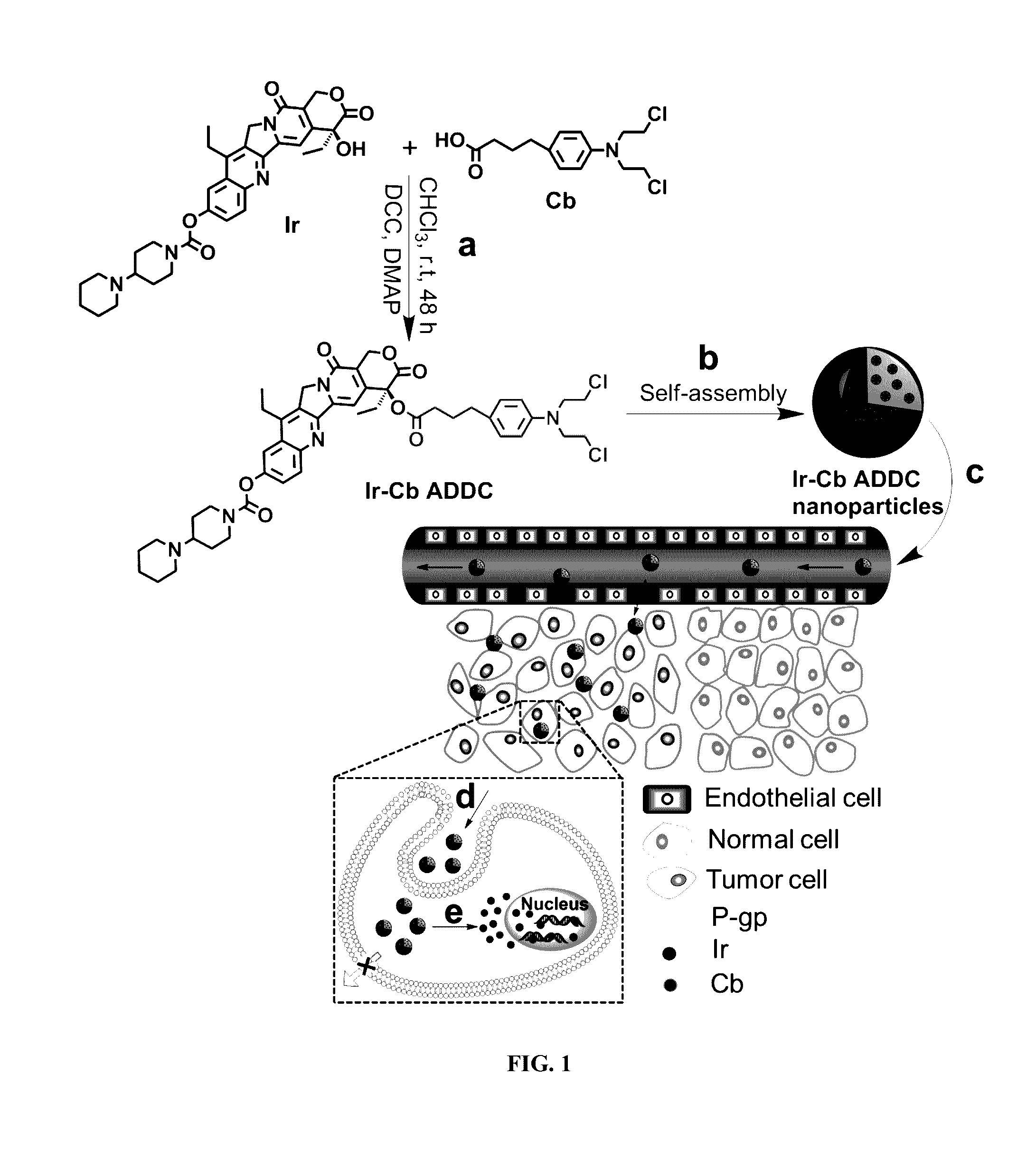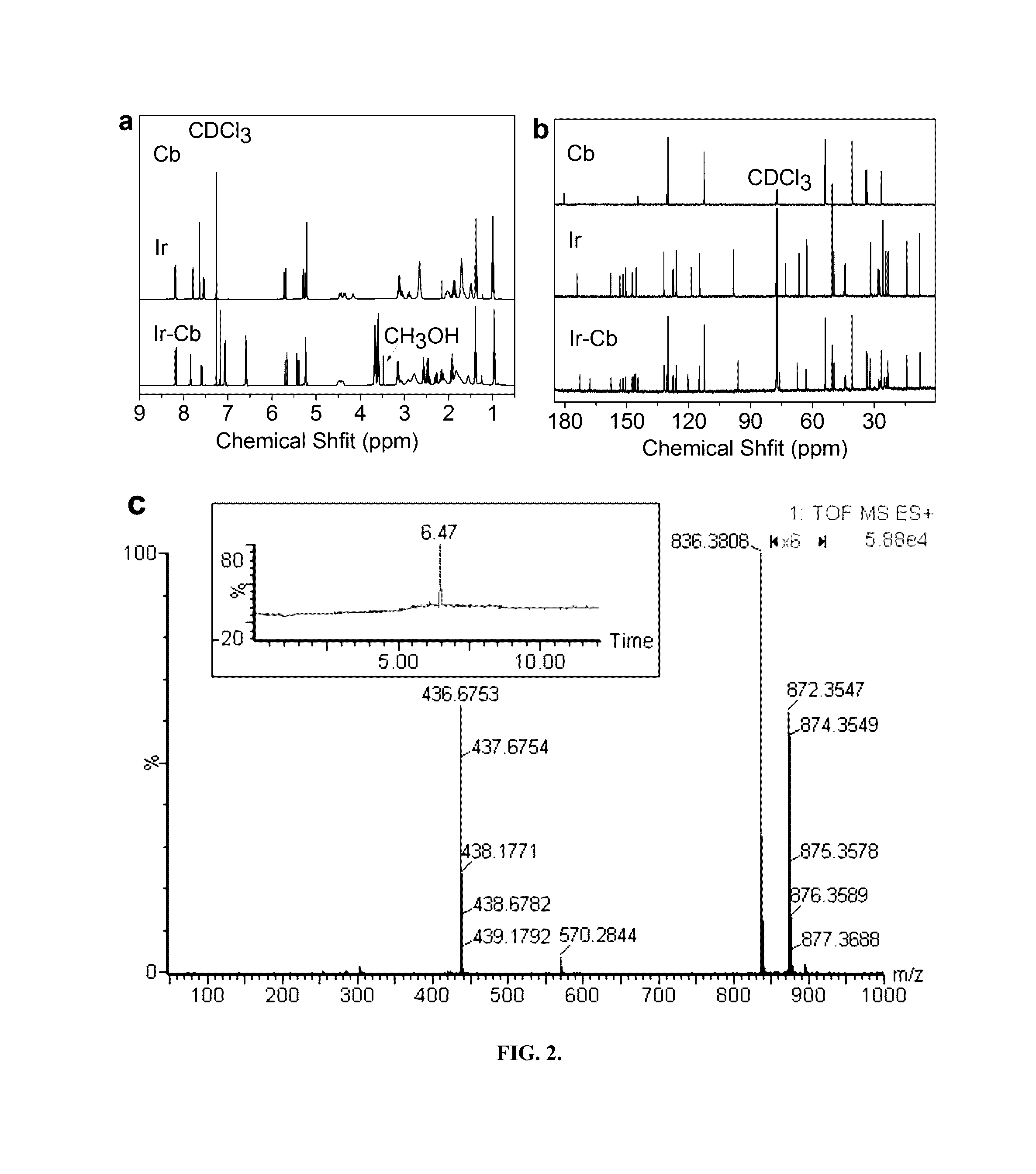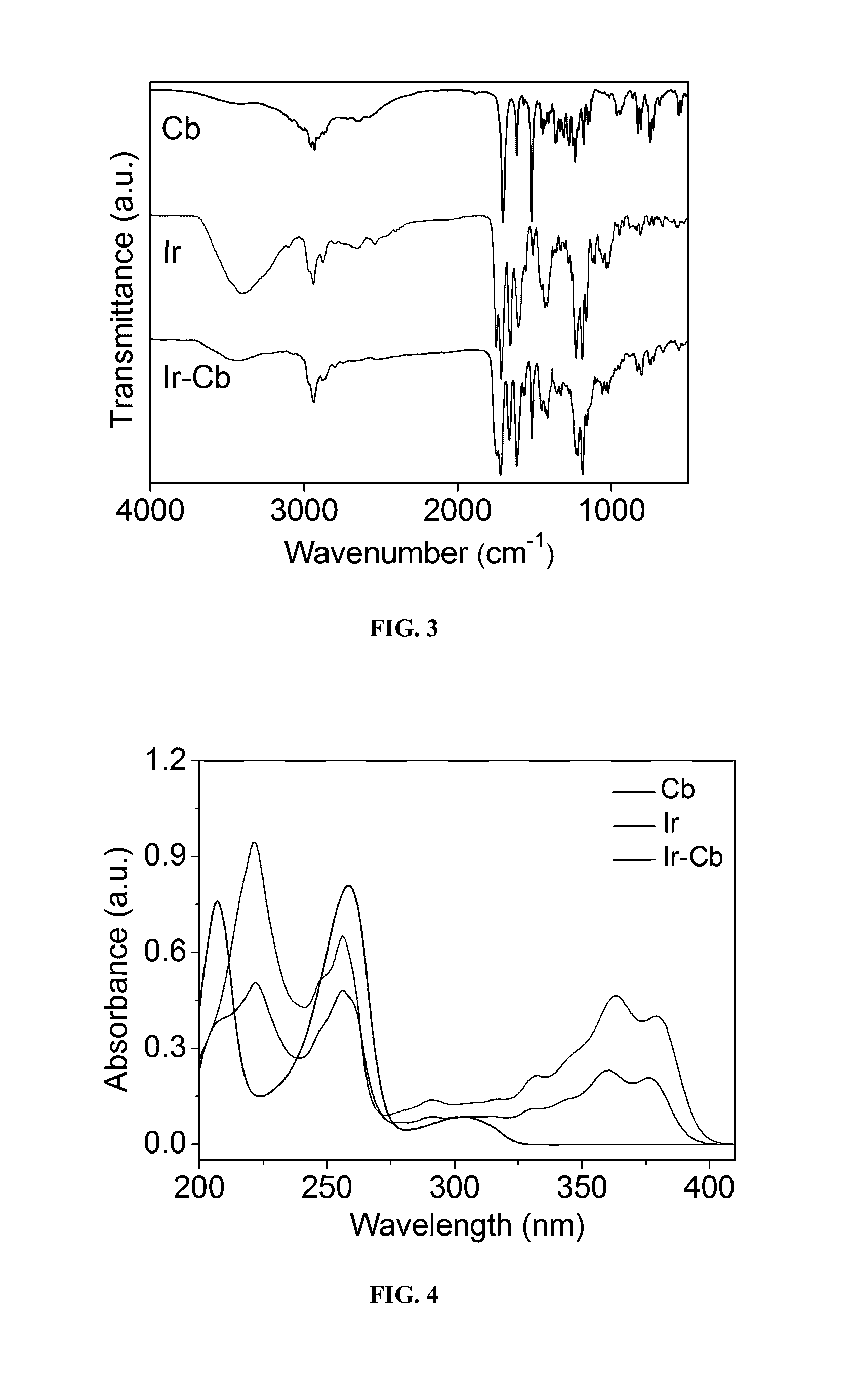Amphiphilic drug-drug conjugates for cancer therapy, compositions and methods of preparation and uses thereof
a technology of amphiphilic drug and conjugate, which is applied in the field of amphiphilic drug-drug conjugates for cancer therapy, can solve the problems of increasing the cost of conventional chemotherapy, so as to promote cellular uptake of addc, prolong the half-life of blood circulation, and enhance the effect of permeability and retention
- Summary
- Abstract
- Description
- Claims
- Application Information
AI Technical Summary
Benefits of technology
Problems solved by technology
Method used
Image
Examples
example 1
Synthesis and Characterization of Ir-Cb ADDC
[0100]The amphiphilic Ir-Cb was synthesized by esterification in DCC / DMAP-catalyzed system and detailed procedure for Ir-Cb conjugate synthesis is described as follows: Cb (0.408 g, 1.34 mmol) and DCC (0.332 g, 1.61 mmol) were dissolved in dried CHCl3 (10 mL), and the mixture was stirred at 0° C. After 30 min, the mixture was added to a solution of Ir (0.157 g, 0.268 mmol), DMAP (0.073 g, 0.6 mmol) and CHCl3 (10 mL), and the resulting solution was stirred for 48 h at room temperature in the dark. Then the reaction mixture was filtered to remove white solids (dicyclohexylurea) and the filtrate was concentrated under vacuum. The crude product was purified by column chromatograph using dichloromethane (CH2Cl2) and dichloromethane / methanol (CH2Cl2:CH3OH, 20:1 v / v) as the eluent. The product was collected and the solvent was removed by rotary evaporation to give a yellowy solid (157 mg, 67%). 1H NMR (400 MHz, CDCl3) δ (ppm): 8.19-8.17 (d, J=8.8...
example 2
Synthesis of the FdU-BdM ADDC
[0115]In a typical procedure, FdU (280 mg, 1.14 mmol), DMAP (5 mg, 0.038 mmol), DCC (95 mg, 0.46 mmol) and TEA (53 μL, 0.38 mmol) were dissolved in anhydrous DMF (6 mL) and the mixture was stirred at room temperature under N2. After 15 min, the BdM (53 μL, 0.38 mmol) in DMF (4 mL) was added dropwise and the reaction mixture was stirred for 48 h at room temperature. Then the reaction mixture was filtered to remove white solids (dicyclohexylurea) and the filtrate was concentrated under vacuum. The crude product was purified by column chromatograph using DCM / CH3OH (12:1, v / v) as the eluent. The product was collected and the solvent was removed by rotary evaporation to obtain FdU-BdM conjugate (155 mg, 69%). 1H NMR (400 MHz, DMSO-d6) δ (ppm) 11.85-11.84 (d, J=4.8 Hz, 1H), 7.91-7.90 (d, J=7.2 Hz, 1H), 7.32-7.30 (d, J=8.8 Hz, 1H), 6.89-6.88 (d, J=2.4 Hz, 1H), 6.78-6.76 (dd, J=8.8 Hz, 1H), 6.13-6.10 (t, J=13.2 Hz, 1H), 5.44-5.43 (d, J=4.4 Hz, 1H), 4.21-4.20 (d,...
example 3
Preparation of the Gem-PAB Conjugate
[0119]PAB (88 mg, 0.2 mmol), DCC (80 mg, 0.4 mmol) and DMAP (24.2 mg, 0.2 mmol) were dissolved in dried DCM (5 mL) and the mixture was stirred at room temperature for 30 min. Then the Gem.HCl (120 mg, 0.4 mmol) in anhydrous DMF (10 mL) was added and the reaction mixture was stirred overnight at room temperature. The reaction was quenched by adding water and then the reaction mixture was extracted with ethyl acetate (EtOAc). The organic phase was collected and washed with brine (2×3 mL), dried with anhydrous Na2SO4. Then the product was purified by column chromatography to give the Gem-PAB conjugate (142 mg, 30.5%). 1H NMR (400 MHz, CDCl3) δ (ppm): 8.16 (d, J=7.5, 1H), 7.44 (d, J=6.5, 1H), 7.19 (s, 1H), 7.04 (d, J=11.1, 1H), 6.51 (dd, J1=14.9, J2=11.1, 1H), 6.22 (s, 1H), 5.77 (d, J=15.1, 1H), 4.30-4.50 (m, 2H), 4.06 (dd, J=8.4, 1H), 3.91 (dd, J=11.0, 1H), 3.72 (s, 3H), 3.32 (s, 1H), 3.07 (d, J=7.5, 1H), 2.88 (d, J=9.1, 1H), 2.74 (m, 1H), 2.61 (m, 1...
PUM
| Property | Measurement | Unit |
|---|---|---|
| Retention time | aaaaa | aaaaa |
| concentration | aaaaa | aaaaa |
| hydrodynamic diameter | aaaaa | aaaaa |
Abstract
Description
Claims
Application Information
 Login to View More
Login to View More - R&D
- Intellectual Property
- Life Sciences
- Materials
- Tech Scout
- Unparalleled Data Quality
- Higher Quality Content
- 60% Fewer Hallucinations
Browse by: Latest US Patents, China's latest patents, Technical Efficacy Thesaurus, Application Domain, Technology Topic, Popular Technical Reports.
© 2025 PatSnap. All rights reserved.Legal|Privacy policy|Modern Slavery Act Transparency Statement|Sitemap|About US| Contact US: help@patsnap.com



